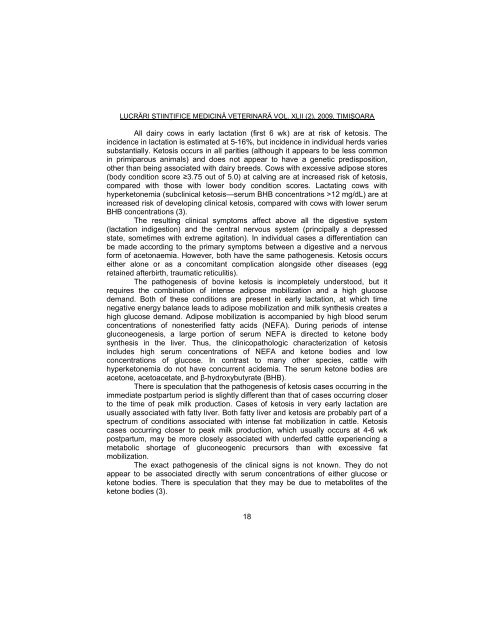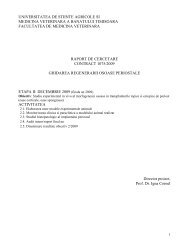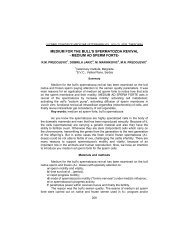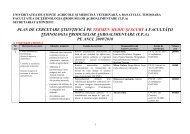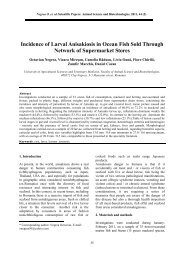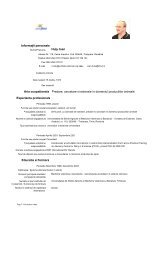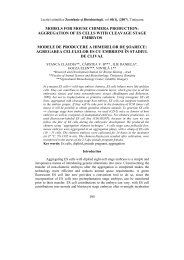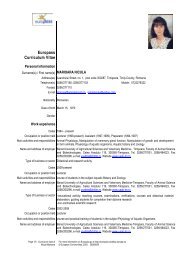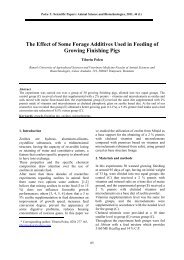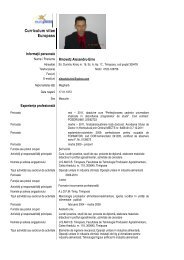influence of osimol® supplementation on productive parameters of ...
influence of osimol® supplementation on productive parameters of ...
influence of osimol® supplementation on productive parameters of ...
Create successful ePaper yourself
Turn your PDF publications into a flip-book with our unique Google optimized e-Paper software.
LUCRĂRI ŞTIINłIFICE MEDICINĂ VETERINARĂ VOL. XLII (2), 2009, TIMIŞOARA<br />
All dairy cows in early lactati<strong>on</strong> (first 6 wk) are at risk <str<strong>on</strong>g>of</str<strong>on</strong>g> ketosis. The<br />
incidence in lactati<strong>on</strong> is estimated at 5-16%, but incidence in individual herds varies<br />
substantially. Ketosis occurs in all parities (although it appears to be less comm<strong>on</strong><br />
in primiparous animals) and does not appear to have a genetic predispositi<strong>on</strong>,<br />
other than being associated with dairy breeds. Cows with excessive adipose stores<br />
(body c<strong>on</strong>diti<strong>on</strong> score ≥3.75 out <str<strong>on</strong>g>of</str<strong>on</strong>g> 5.0) at calving are at increased risk <str<strong>on</strong>g>of</str<strong>on</strong>g> ketosis,<br />
compared with those with lower body c<strong>on</strong>diti<strong>on</strong> scores. Lactating cows with<br />
hyperket<strong>on</strong>emia (subclinical ketosis—serum BHB c<strong>on</strong>centrati<strong>on</strong>s >12 mg/dL) are at<br />
increased risk <str<strong>on</strong>g>of</str<strong>on</strong>g> developing clinical ketosis, compared with cows with lower serum<br />
BHB c<strong>on</strong>centrati<strong>on</strong>s (3).<br />
The resulting clinical symptoms affect above all the digestive system<br />
(lactati<strong>on</strong> indigesti<strong>on</strong>) and the central nervous system (principally a depressed<br />
state, sometimes with extreme agitati<strong>on</strong>). In individual cases a differentiati<strong>on</strong> can<br />
be made according to the primary symptoms between a digestive and a nervous<br />
form <str<strong>on</strong>g>of</str<strong>on</strong>g> acet<strong>on</strong>aemia. However, both have the same pathogenesis. Ketosis occurs<br />
either al<strong>on</strong>e or as a c<strong>on</strong>comitant complicati<strong>on</strong> al<strong>on</strong>gside other diseases (egg<br />
retained afterbirth, traumatic reticulitis).<br />
The pathogenesis <str<strong>on</strong>g>of</str<strong>on</strong>g> bovine ketosis is incompletely understood, but it<br />
requires the combinati<strong>on</strong> <str<strong>on</strong>g>of</str<strong>on</strong>g> intense adipose mobilizati<strong>on</strong> and a high glucose<br />
demand. Both <str<strong>on</strong>g>of</str<strong>on</strong>g> these c<strong>on</strong>diti<strong>on</strong>s are present in early lactati<strong>on</strong>, at which time<br />
negative energy balance leads to adipose mobilizati<strong>on</strong> and milk synthesis creates a<br />
high glucose demand. Adipose mobilizati<strong>on</strong> is accompanied by high blood serum<br />
c<strong>on</strong>centrati<strong>on</strong>s <str<strong>on</strong>g>of</str<strong>on</strong>g> n<strong>on</strong>esterified fatty acids (NEFA). During periods <str<strong>on</strong>g>of</str<strong>on</strong>g> intense<br />
gluc<strong>on</strong>eogenesis, a large porti<strong>on</strong> <str<strong>on</strong>g>of</str<strong>on</strong>g> serum NEFA is directed to ket<strong>on</strong>e body<br />
synthesis in the liver. Thus, the clinicopathologic characterizati<strong>on</strong> <str<strong>on</strong>g>of</str<strong>on</strong>g> ketosis<br />
includes high serum c<strong>on</strong>centrati<strong>on</strong>s <str<strong>on</strong>g>of</str<strong>on</strong>g> NEFA and ket<strong>on</strong>e bodies and low<br />
c<strong>on</strong>centrati<strong>on</strong>s <str<strong>on</strong>g>of</str<strong>on</strong>g> glucose. In c<strong>on</strong>trast to many other species, cattle with<br />
hyperket<strong>on</strong>emia do not have c<strong>on</strong>current acidemia. The serum ket<strong>on</strong>e bodies are<br />
acet<strong>on</strong>e, acetoacetate, and β-hydroxybutyrate (BHB).<br />
There is speculati<strong>on</strong> that the pathogenesis <str<strong>on</strong>g>of</str<strong>on</strong>g> ketosis cases occurring in the<br />
immediate postpartum period is slightly different than that <str<strong>on</strong>g>of</str<strong>on</strong>g> cases occurring closer<br />
to the time <str<strong>on</strong>g>of</str<strong>on</strong>g> peak milk producti<strong>on</strong>. Cases <str<strong>on</strong>g>of</str<strong>on</strong>g> ketosis in very early lactati<strong>on</strong> are<br />
usually associated with fatty liver. Both fatty liver and ketosis are probably part <str<strong>on</strong>g>of</str<strong>on</strong>g> a<br />
spectrum <str<strong>on</strong>g>of</str<strong>on</strong>g> c<strong>on</strong>diti<strong>on</strong>s associated with intense fat mobilizati<strong>on</strong> in cattle. Ketosis<br />
cases occurring closer to peak milk producti<strong>on</strong>, which usually occurs at 4-6 wk<br />
postpartum, may be more closely associated with underfed cattle experiencing a<br />
metabolic shortage <str<strong>on</strong>g>of</str<strong>on</strong>g> gluc<strong>on</strong>eogenic precursors than with excessive fat<br />
mobilizati<strong>on</strong>.<br />
The exact pathogenesis <str<strong>on</strong>g>of</str<strong>on</strong>g> the clinical signs is not known. They do not<br />
appear to be associated directly with serum c<strong>on</strong>centrati<strong>on</strong>s <str<strong>on</strong>g>of</str<strong>on</strong>g> either glucose or<br />
ket<strong>on</strong>e bodies. There is speculati<strong>on</strong> that they may be due to metabolites <str<strong>on</strong>g>of</str<strong>on</strong>g> the<br />
ket<strong>on</strong>e bodies (3).<br />
18


